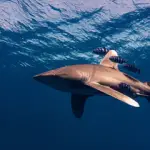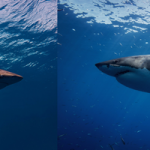
Scuba diving with sharks is mostly very safe and and in most cases sharks don’t attack scuba divers. So what happened with the Brothers shark attack, and why did this oceanic whitetip attack a diver?
The Red Sea Brothers shark attack by an oceanic whitetip shark on a scuba diver is very rare and could’ve been prevented. The Brothers shark attack could have been avoided if the diver was vertical in the water, kept his eyes on the shark and joined a group of divers to be intimidating to the shark.
The best way to dive the Red Sea, and especially the best and more remote locations in the Red Sea, is by a scuba diving liveaboard. You can check the latest and best deals on Red Sea liveaboards using the following window:
Video of the oceanic whitetip shark (Carcharhinus Longimanus) attack at the Brothers Red Sea
In this scenario there are a group of divers diving from a Red Sea liveaboard, which is the only way to scuba dive the Brothers Islands on a Red Sea diving safari.
Please watch this Red Sea shark attack video, before you read the shark diving safety advice given below. These are my four rules to stay safe when scuba diving with sharks, which could have prevented this oceanic whitetip shark attack at the Brothers Islands in the Red, Egypt.
But please don’t let this Brothers shark attack put you off from diving with sharks in the future, or from scuba diving in the Red Sea, as attacks of this nature on scuba divers are extremely rare (see shark attack statistics below).
Plus if you read my four rules to stay safe when diving with sharks, this type of accident should never happen in the first place.
Before you read on, you may also like to take a watch of both the videos on this article about what fish eat sharks. You may be as surprised as I was when you see what happens! What fish can eat sharks?
Famous shark attack at the Brothers Egypt
How the oceanic whitetip shark attack in the Red Sea could have been avoided
There are four rules for staying safe when scuba diving with sharks. These rules can be remembered using the HUGE acronym.
To help you remember the acronym, think about how it would be a HUGE mistake not to follow the rules when diving with sharks.
The four shark safety rules include:
- H – Hands: Keep your hands to your self and fold your arms with your hands under your armpits.
- U – Upright: Stay upright and vertical in the water, as this looks strange to sharks that are accustomed to other sea creatures, or they prey, swimming horizontally underwater. There are no other animals that travel upright in the water, so this confuses sharks.
- G – Group: Stay in a group, which means you will be seen as a whole and more difficult to attack. This is more intimidating for sharks. If you stray from other divers in the group this can make you a target and more vulnerable to attack.
- E – Eyes: Keep your eyes on the shark or sharks at all times. All predators look for vulnerabilities and want to avoid being injured themselves, so most sharks tend to attack from below or from behind where there’s less likelihood they will get injured in the attack.
Other tips are to not swim backwards away from the shark, stay as calm as you can, keep your distance (although this is not always possible as oceanic whitetip sharks will approach you), but try to stay above the shark if you can.
But if the Longimanus shark gets too close use a prod-stick to push it away, with force if necessary, and where possible on its sensitive nose.
So now re-watch the Red Sea shark attack video and see which of these rules the scuba diver broke. Which of the four shark safety rules did he break that lead to him being attacked by this oceanic whitetip shark. I explain my views on this below.

Shark behaviour depends on the size of the shark
Always remember that the bigger the shark, the more curious it will be, and the more likely it will get closer to you. But on the whole sharks tend to stay away from divers, unless they are being fed, like they do at Tiger Beach Dive in the Bahamas.
Most sharks will keep their distance from you, so there’s no real threat, so enjoy them, look at them and try not to scare them away. Plus never ever provoke a shark, as this is when they are more likely to attack you.
Most shark attacks are on surfers, snorkelers and swimmers, which is no consolation to these water users, but it does mean that scuba divers are safe when in the water with sharks.
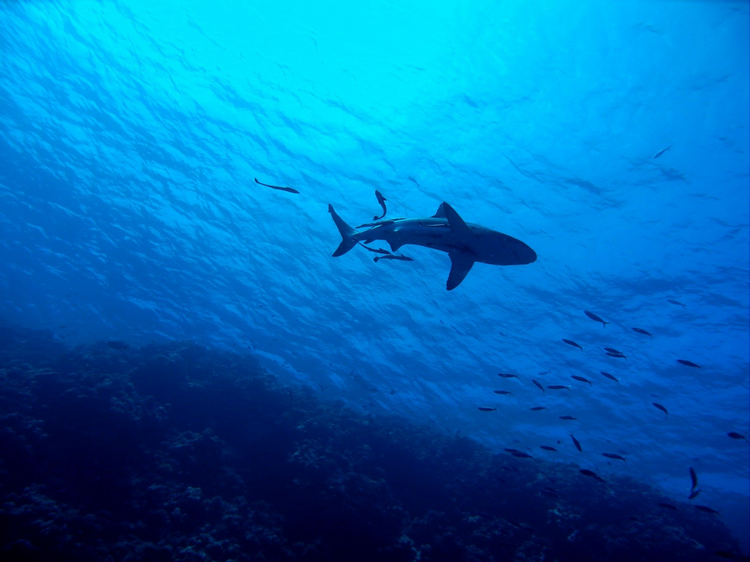
How likely is a shark to attack you?
Keep in mind when you watch the above Red Sea shark attack video that a person’s chance of getting attacked by a shark is 1 in 11.5 million, and a person’s chance of getting killed by a shark is 1 in 264.1 million.
These chances of getting attacked are reduced further for scuba divers, as divers are the least likely of all water users to be attacked by sharks. But also, when you consider the thousands of divers who visit the Brothers Islands dive site every month, you’ll understand how interactions like this are extremely rare.
I’ve been scuba diving with sharks for over 30 years and I’ve never had such an interaction with any of the sharks I’ve dived with. Having said that, oceanic whitetip sharks are much bolder than most sharks and are fearless.
How to avoid a shark attack
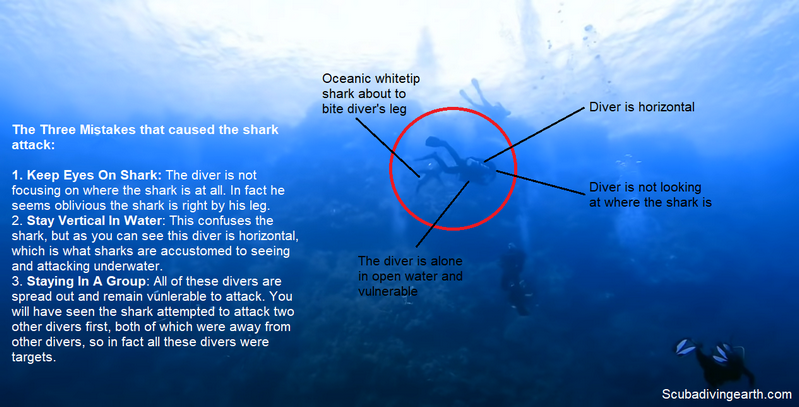
Using the above H.U.G.E. acronym, how could the diver in the above video have prevented the oceanic whitetip shark attack, which was clearly intent on attacking at least one of these divers.
- H – Hands: In this case the diver’s hands didn’t affect the situation.
- U – Upright: The diver was horizonal in the water and made himself into an easy target. If the diver who was attacked was upright and vertical in the water he would have been less of a target.
- G – Group: Most of the divers could easily be singled out and were vulnerable to attack. The shark attempted to attack two lone divers before it was successful on its third attempt. If the divers in open water have grouped together this would have been more intimidating for the shark.
- E – Eyes: The diver who was attacked didn’t keep his eyes on the oceanic whitetip shark and was taken by surprise. He was an easy target. Notice how the previous two attempts were prevented because the divers were watching the shark’s movements carefully and were able defend themselves when the shark attempted to attack. If the diver that was attack by the oceanic whitetip had kept his eyes on the shark he may have been able to avoid being bitten.
There are three more steps to take if the shark is getting too close, which include:
- Make noise with bubbles and exhale from your regulator as much as you can.
- Scream underwater, as this may scared the shark.
- If the shark is intent on biting you, punch the shark on the nose, as this is like kicking a human in the balls. A shark’s nose is very sensitive.
The shark in the above video was in feeding mode and it was happy to eat one of the divers. When these oceanic whitetips are like this you need to be extremely careful, otherwise you may get bitten.
Above all, you must not panic and don’t try to swim away. If you swim away, you’ll simply encourage the shark to attack even more. Always bear in mind that you could never out-swim a shark, and by swimming away you’ve just broken at least three of the above shark diving safety rules, namely; you’ve taken your eyes off the shark, you’re now horizonal in the water, and you’ve isolated yourself away from the group.
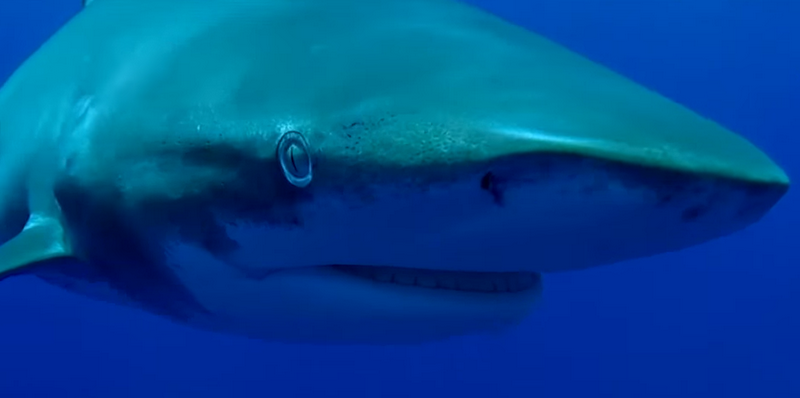
How to reduce the risk of a shark attack
You can reduce the risk of a shark attack by cutting down on attack routes, including going to the seabed to prevent attacks from below. Sharks also attack from behind, so place yourself in front of a sea wall with your back to it and keep your eyes on the shark, as this cuts out a rear attack.
Important note: the above evasive advice is only applicable if a rogue shark is behaving in an unusual way, like in the above Red Sea shark attack by an oceanic whitetip shark. Ordinarily there’s no need to take defensive action in the way I describe.
An observation in this regard when you watch the shark attack video, is to notice how the oceanic whitetip shark only attacked or attempted to attack the divers in open water.
If you watch the video again, you’ll notice there are plenty of divers with their backs to the sea wall. This is the safest place to be in this situation. Their alternative to protecting their backs against this sea wall would have been to go to the seabed, assuming the seabed isn’t too deep for divers.
Given the choice in this situation, the sea wall is the better one. Going deeper would mean their air consumption would increase.
Having your back protected by a wall or the seabed cuts down on the angles of an attack by a shark.
“Pelagic or oceanic species of shark often feed opportunistically because the open ocean can be a sparse environment for food“, David Jacoby a shark behaviour specialist at The Marine Biological Association of the UK.
This means that oceanic whitetip sharks are opportunists or opportunistic feeders and will always take the easy option if they are given a choice.
The divers in open water, or the divers on their own and in open water and away from a group of divers, are easier targets and are less intimidating for a shark.
The diver who was attacked should have swam to the wall and positioned himself with his back to the wall and vertically in the water. He could then watch the shark’s movements, whilst knowing it couldn’t come at him from behind.
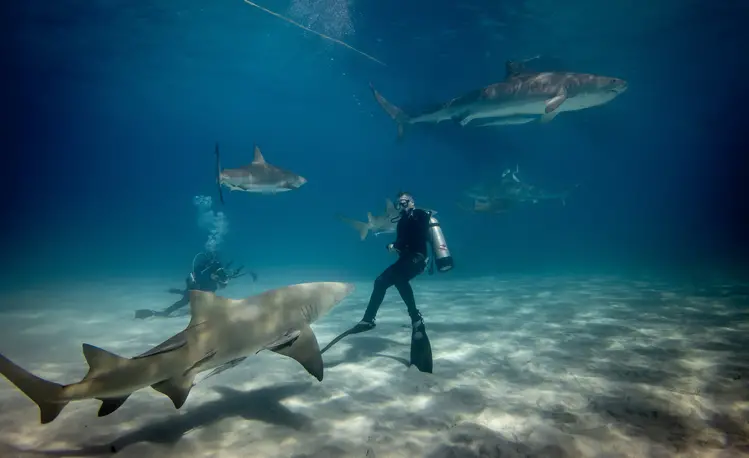
How to know if a shark is going to attack
Shark attacks are always preceded by a clear pattern, which is easy to spot and easy to stop.
Patterns to notice when a shark is going to attack
- The shark will circle around you.
- The shark will then make a line straight towards you and divert away.
- It may also lower it’s pectoral fins, which is a sign of aggression.
- Next the shark will make a smaller circle.
- The shark will once more head straight towards you and divert away a little bit later this time.
- The next circle will be even smaller and the shark will divert even later, and so on.
- The next time the shark will not divert and will bump you. This is how the shark “feels” what you are…the shark is testing you.
- If after bumping you it doesn’t get a sense of what you are, it will take a bite.
- The bite is simply to taste and feel what you are, as they can’t feel you in any other way.
- It’s unlikely to do more than a test bite, as it will soon realise you are not prey, but sadly this can be too late.
- Sharks have lots of sharp teeth, and depending on where they bite, this can be fatal. For example, in the above oceanic whitetip shark attack in the Red Sea, the diver’s leg was bitten. Fortunately the diver survived the attack.
Please note: Oceanic whitetip sharks don’t necessarily conform to the above rules, as they will often swim straight towards a diver instead of circling. They are fearless sharks. For that reason, you may like to watch this video when Planet Earth were filming three oceanic whitetip sharks.
Follow the truly amazing story of one Planet Earth cameraman’s desperate search for the perfect slow motion shot of an Oceanic Whitetip Shark in South Africa’s shallow seas, just off the coast of Cape Town
The Brothers shark attack happened in 2020 and soon after it happened the Brothers was closed for several months.
What to do if a shark is circling you?
In the unlikely event a shark is circling you with what appears to be an intent to attack, or in the case of an oceanic whitetip shark it swims directly towards you, follow these safety precautions:
- Don’t panic and don’t swim away.
- Keep your hands folded and under your armpits.
- Stay vertical in the water.
- Group together with your dive buddies with your backs towards the centre looking out.
- Keep your eyes on the shark.
- Make noise to unnerve the shark.
- Slowly make your way to the surface as a group.
It is also worth noting that just because sharks are circling you, it doesn’t necessarily mean they are going to attack. I recall a dive in the Bahamas and being surrounded by many circling sharks.
As these large sharks circled, they were also approaching me and then changing direction as they got closer to me, as I hovered vertically in the water with my arms folded in front of me. For me this was exciting and an amazing experience and at no point did I feel these sharks would ever attack.
How dangerous is the oceanic whitetip shark?
Oceanic whitetip sharks can be dangerous to humans and are known to have attacked survivors of ship wrecks in the past. Whilst oceanic whitetips are very curious with scuba divers, and divers need to be wary of them, it’s extremely rare for them to attack scuba divers.
It is thought that oceanic whitetip sharks have killed and eaten more people than any other shark on the planet. For example, of the 900 sailors that survived the sinking of USS Indianapolis on 30 July 1945, only 317 of them survived. It is thought that the rest were killed and eaten by oceanic whitetip sharks. If this interests you, you may like to watch this video:
History says oceanic white tip sharks are the world’s deadliest sharks. Dr. Michael Domeier goes looking for them to see if the species really are the most dangerous of sharks.
Seeing that you’re interested in scuba diving with sharks, or at least interested in staying safe around sharks, you may also like to read this article about great white sharks in the Caribbean and the Gulf of Mexico.
You may be surprised by what you read, I certainly was!
This article is also interesting about a great white shark pinged near to the Maldives.
But then if you want to be really surprised, take a read of this article about a great white shark spotted by a snorkeler off the southern Great Barrier Reef. The article includes a video of the white shark concerned.
Booking your diving trip to The Brothers Islands
I would hope that you’ve not been discouraged from scuba diving the Red Sea after reading this article and from watch the videos I’ve included. Assuming this is the case, and I sincerely hope it is, I suggest you book a Red Sea liveaboard diving safari to dive The Brothers dive site, as this is the only way to dive this there.
For this, you can either use this article: The Best Red Sea Liveaboard Dive Boats, or use the handy window below to search for your chosen Red Sea liveaboard. The benefit of using the article, is that I’ve included a handy table that lists all the Red Sea liveaboards. This table includes a column to confirm which Red Sea liveaboards visit The Brothers Islands dive site, along with some other very useful information too about each liveaboard dive boat.
Table of liveaboard diving in the Red Sea
This list of Red Sea liveaboards is in descending customer rating order, followed by Scuba Diving Luxury Rating (SDE Lux Rating, see below), so the liveaboards with the highest customer rating and the best SDE lux rating will be at the top of the list. If you want to change the list order, use the “Sort by” dropdown below.
| Discover Liveaboard | Customer Rating | SDE Lux Rating % | Flexible Booking | Dive Courses | Dietary Requirements | Nitrox | Gear Rental | |
|---|---|---|---|---|---|---|---|---|
 | Review: MY Hammerhead I; Book: MY Hammerhead I | 10 | 71% | YES | YES | YES | YES | YES |
 | Review: MV Andromeda; Book: MV Andromeda | 10 | 65% | NO | YES | YES | YES | YES |
 | Review: MV Ghani; Book: MV Ghani | 10 | 50% | YES | YES | YES | YES | YES |
 | Review: MY Sea Friend; Book: MY Sea Friend | 9.6 | 71% | YES | YES | YES | YES | YES |
 | Review: MY Aldebaran; Book: MY Aldebaran | 9.6 | 67% | YES | YES | YES | YES | YES |
 | Review: MY Aphrodite; Book: MY Aphrodite | 9.5 | 88% | YES | YES | YES | YES | YES |
 | Review: MY Seven Seas; Book: MY Seven Seas | 9.5 | 87% | YES | YES | YES | YES | YES |
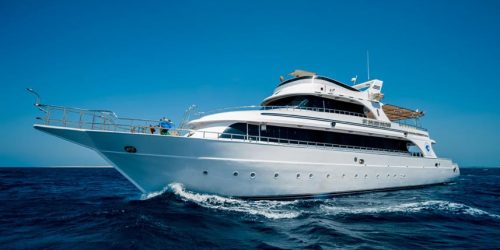 | Review: MY Golden Dolphin; Book: MY Golden Dolphin | 9.5 | 77% | YES | YES | YES | YES | YES |
 | Review: MV Dolce Vita; Book: MV Dolce Vita | 9.5 | 69% | YES | YES | YES | YES | YES |
 | Review: MY Blue; Book: MY Blue | 9.5 | 63% | YES | YES | YES | YES | YES |
The Scuba Diving Earth Luxury Rating (SDE Lux Rating) is explained on each liveaboard review when you click the “Discover Liveaboard” link, and is my own Liveaboard Luxury Rating I’ve assigned to all liveaboards. Choosing between liveaboards is helped by customer scores, and if you get stuck choosing between two or three liveaboards, where each one has a high customer score out of 10, you can use the SDE Luxury Rating to help narrow down your choice.
Think about it like using Booking.com when searching for the best hotel. Booking.com also use a customer score where each customer rates hotels out of 10. This is similar to the liveaboard customer rating, which is also rated out of 10. But let’s say you only like to stay in hotels rated 8 and above on Booking.com, but you also want the hotel to have WIFI or parking, or to have a swimming pool etc. The features each hotel has is usually secondary to the score out of 10.
Additionally, if you would like to find out when is the best time to see oceanic whitetip sharks at The Brothers Islands dive site, please take a read of this article too: “The Brothers Red Sea: Brothers Islands Scuba Diving“. In this article I include a very handy table which shows a summary from 135 reviews of divers who visited The Brothers Islands and when most sightings of oceanic whitetip sharks occurred, as well as sightings of other sharks and manta rays.
But another Red Sea dive you may like to consider is Daedalus Reef, where oceanic whitetips sharks are seen on a regular basis. Please take a look at this article “Red Sea Daedalus Reef Dive Site: Shark Diving“. This article includes a handy table which is a summary from 148 scuba divers and when they saw most oceanic whitetip sharks, plus other sharks and manta rays.
I hope you enjoyed this page about Brothers shark attack Egypt
If you have more questions either about snorkelling or scuba diving (or specifically about Brothers shark attack Egypt ), please comment below with your questions.
Please share your experiences, plus dive sites, resorts and liveaboards you recommend. Share the time of year of your trip together with what you saw, the visibility, currents and dive operator, as this will help others who read this page.
There will also be many more pages and articles about scuba and scuba diving safety tips (and on snorkelling too) for you to read and learn about this fabulous sport.
Have fun and be safe!


